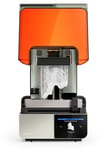Professional-level resin 3D printing is used for everything from tools, molds, and prototypes to end-use sports equipment and even dentures. These machines typically feature larger build volumes than their consumer-level cousins, more advanced and durable material options, and the ability to finely tune the part quality and achieve consistency over larger volumes.
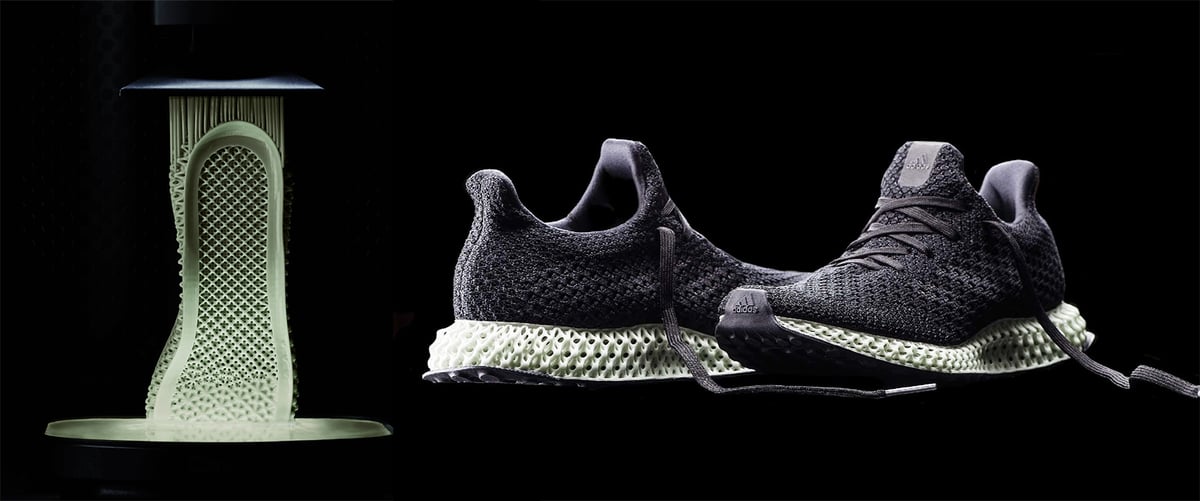
Resin printing is prized by companies in virtually every industry that needs:
- parts comparable to injection molding
- parts with intricate details, complex geometries, and fine features
- parts with very smooth surfaces or soft textures
- parts in various materials (flexible prints one day, sturdy prints the next, etc.)
- parts in biocompatible plastics
- transparent parts
In this guide, we walk you through the essentials of resin printing technology (the difference between LCD, DLP, SLA), what to look for in a professional resin printer, what you need to know about advanced resin materials, and when it makes more sense to opt for a resin 3D printing service.
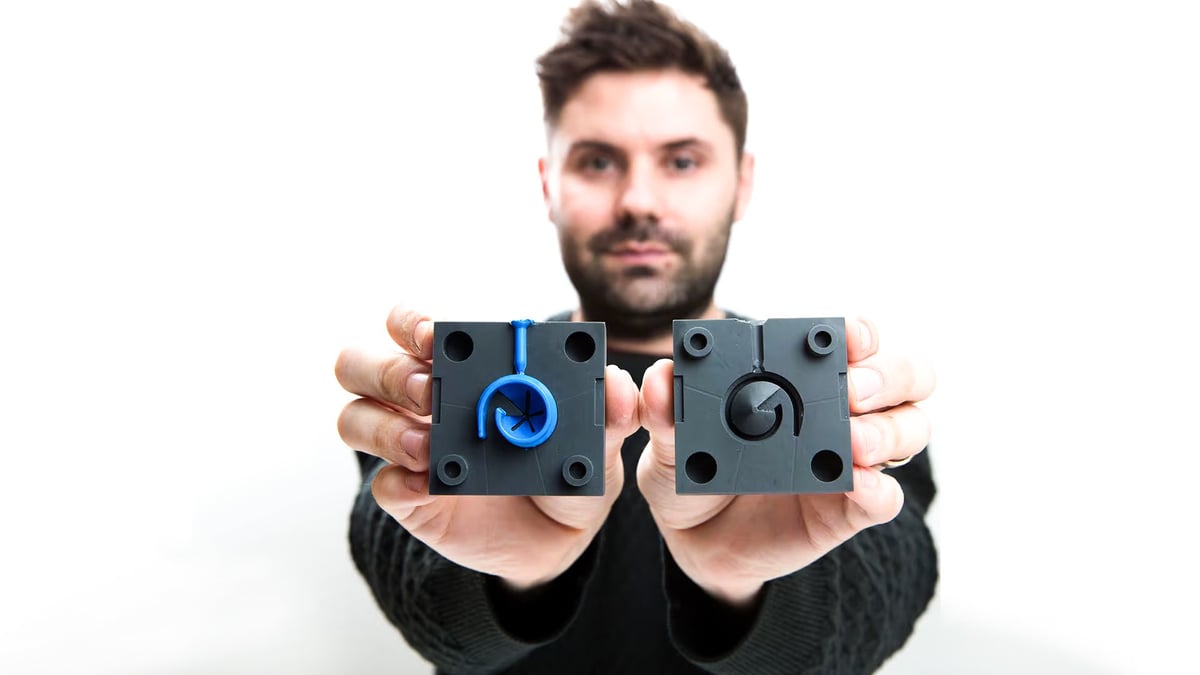
What Makes a Resin 3D Printer Professional?
The line between consumer and professional resin 3D printers can be blurry, but here we focus on machines from about $5,000 up to $450,000. If your budget is smaller ($200 – $4,000) or you’re new to the technology, you could find a printer to fit your needs in our guide to smaller and hobby-focused resin 3D printers.
No Dental Printers Here
In recent years, there’s been a massive shift in the resin 3D printer market. Since dental applications account for a huge percentage of professional resin 3D use, many 3D printer manufacturers now focus strictly on the billion-dollar dental 3D printing market.
All3DP has a seperate dental-specific resin 3D printer guide linked below:
Resin and wax 3D printing for the jewelry industry is also a rapidly growing market with some specialized printers. We take a closer look at 3D printers for jewelry molds in this guide linked below:
Micro 3D printing is also heavily reliant on resins, but we feature those printers in our Micro 3D Printing Guide.
Remove dental, jewelry, and micro resin 3D printers and you’re left with those that focus on manufacturing in highly durable and flexible materials. Not that some of these can’t be used for dental and jewelry, but the main goal to deliver rigid and extremely accurate durable parts.
All resin printers do not use the same technology so if you don’t know a DLP from an SLA from an LMM, skip to the technology section first.
| company | Price | Min. Resolution | Resin Tech | Build Volume |
|---|---|---|---|---|
| Raise3D DF2 Solution | $2,500 | DLP / Z: 50 µm | DLP | 200 × 112 × 300 mm |
| Formlabs Form 4 | $3,500 | LCD / XY: 50 μm, Z: 25 μm | LCD | 200 x 125 x 210 mm |
| Photocentric LC Magna | $16,200 | LCD / XY: 137 µm, Z: 25 - 100 µm | LCD | 510 x 280 x 350 mm |
| B9Creations B9 Core 6 Series MPro | $22,000 | DLP / XY: 50 µm, Z: 10 µm | DLP | 192 x 108 x 320 mm |
| Asiga Ultra 50 | $15,000 | DLP / XY: 50 μm, Z: - | DLP | 189 x 106 x 130 mm |
| Stratasys Origin Two | n.a. | DLP / XY: 50 μm, Z: 25 - 200 μm | DLP | 192 x 108 x 370 mm |
| Rapid Shape I100+ | $120,000 | DLP / XY: 44 μm, Z: 35 μm | DLP | 400 x 335 x 190 mm |
| ETEC Xtreme 8K | ~$225,000 | DLP / XY: 100 µm, Z: 100 µm | DLP | 450 x 371 x 399 mm |
| Carbon M3 Max | ~$250,000 (3-year lease) | DLP / XY: 75 µm, Z: 25 - 100 µm | DLP | 307 x 163 x 326 mm |
| 3D Systems PSLA | ~ $420,000 | DLP / XY: 90 µm, Z: 50 µm | DLP | 242 x 265 x 300 mm |
| SoonSer Smart 400H | - | SLA / XY: 100 μm, Z: 50 μm | SLA | 400 x 400 x 300 mm |
Top Pro Resin 3D Printers
Raise3D DF2 Solution
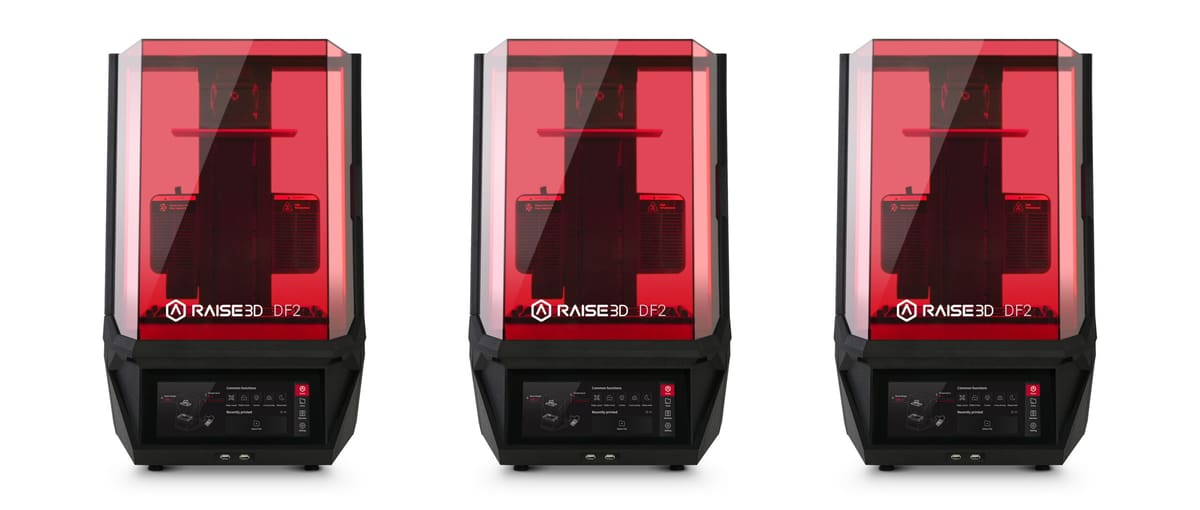
The new DF2 Solution from Raise3D is the company’s first resin printer after having made very popular filament machines for many years. It ‘s a bold move to enter the crowded pro-desktop resin market but, as with everything Raise3D does, it approached resin with the end-user in mind and a focus on usability.
This DLP 3D printer is billed as a total “solution” for manufacturers, which includes a washing unit, a curing unit, software, and material cartridges. The solution boasts “traceable workflow” features, which include a “smart build plate” that integrates with both post-processing devices and has an embedded RFID tag that records the type of resin being used, in addition to washing and curing settings. This allows various operators to manage the washing and curing phases regardless of their familiarity with the products being produced.
The DF2 with washing and curing units are priced at about $6,200.
Formlabs Form 4
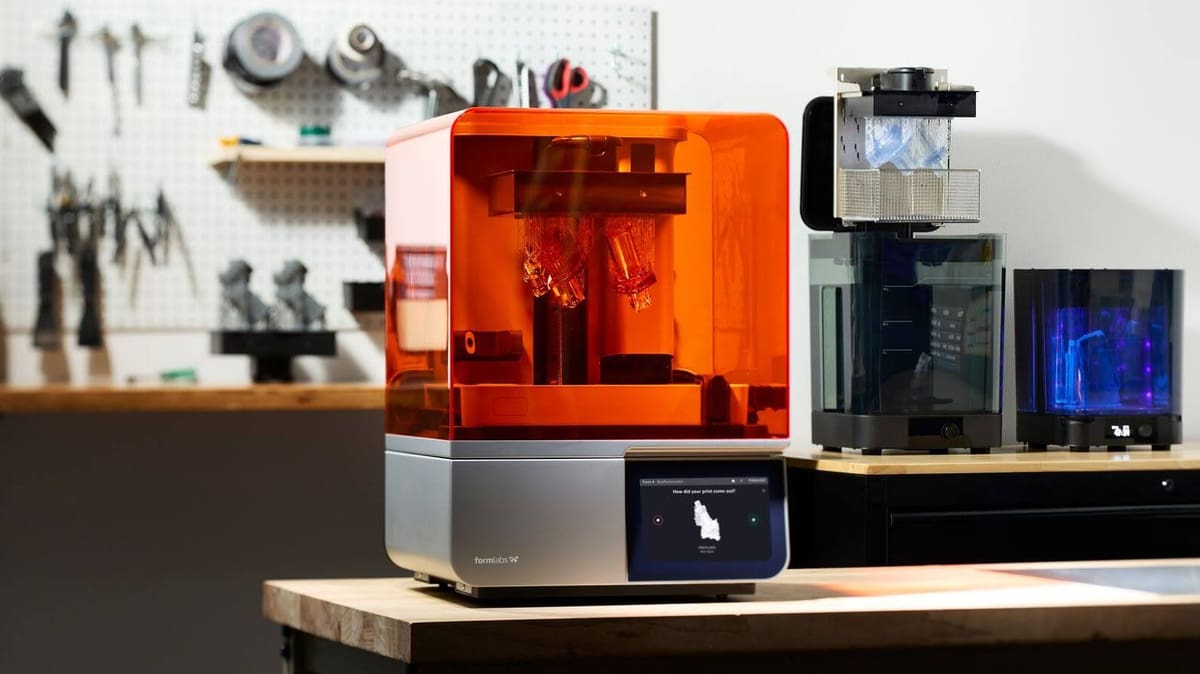
Formlabs has sold more than 130,000 3D printers since it launched the Form 1 in 2012, making it one of the best selling professional 3D printer makers. It has several models for engineering applications, as well as several for healthcare and dental. The company launched its newest SLA printer, the Form 4, in Spring 2024, which is five-times faster than previous models.
The Form 4 represents a major technology shift for the company, which has relied on laser-based resin 3D printing technology but made the change to LCD (liquid-crystal display) technology, also known as masked stereolithography (mSLA).
Instead of a laser tracing out each layer point-by-point, the Form 4 features an array of LED lights shining through an LCD screen to cure an entire layer of resin at once. Form 4’s vastly improved print time wasn’t possible on a single-laser SLA.
The the trade-off for Form 4’s LCD speed is a small difference in print resolution when comparing the Form 4 to the Form 3+ (50 microns in the XY vs. 25 microns). The Form 4, being LCD technology, lists resolution slightly differently – it has a 50-micron pixel size, yet, couple this with “pixel smoothing,” which is technology in a printer’s slicing software, and the resolution of the Form 4 should effectively equal the Form 3+ in most applications.
Form 4, like all Formlabs’ printers, features a mess-free, easy to use, material cartridge system, not bottles. In addition to validated materials and detailed print profiles, you can purchase a license to “open” the material settings and use any resin you wish. But the big news in materials is that they are cheaper, Formlabs says, starting at around $79 per liter instead of $150 for Form 3+ materials. Not only cheaper, but several have been enhanced to deliver better mechanical properties, the company says.
In 2023, Formlabs launched its Automation Ecosystem, which is a hardware and software solution that enables your printers to print parts around the clock without your help. The aim is to enable large-batch 3D printing to reduce cost per part and manual labor.
Photocentric LC Magna
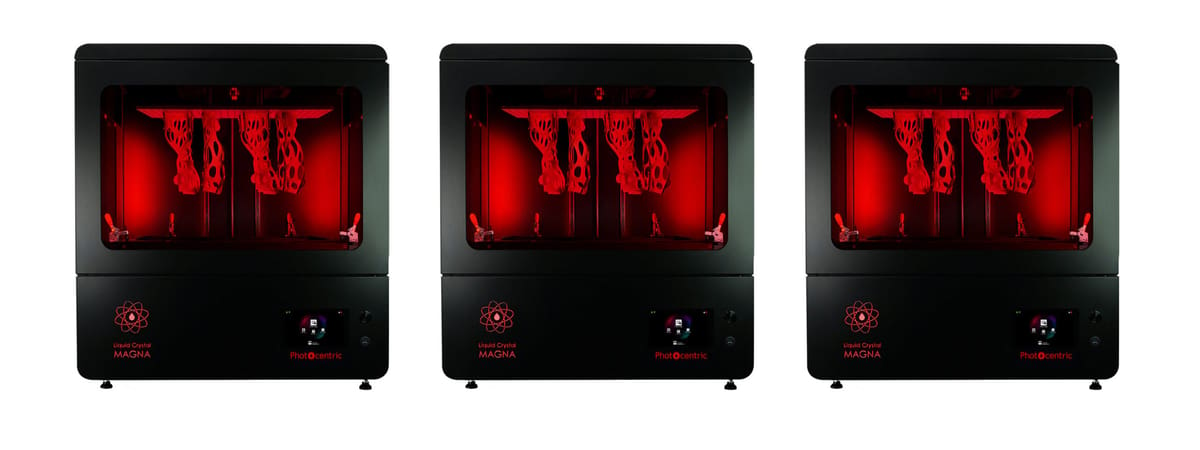
Photocentric’s LC Magna Liquid Crystal Magna) is a large-format LCD-based resin 3D printer that’s larger that it looks in photos. It has a build volume of 510 × 280 × 350 mm, which enables users to print volumes of parts as well as large parts. Its high-speed printing capabilities stem from its monochrome LCD screen, which cures resin rapidly, reducing layer exposure times and increasing efficiency, the company says.
The printer also delivers nice precision and detail for its size, with an XY resolution of 137 µm. The LC Magna is compatible with a variety of Photocentric’s proprietary resins, including engineering, dental, and casting resins, which enhances its versatility across different industries.
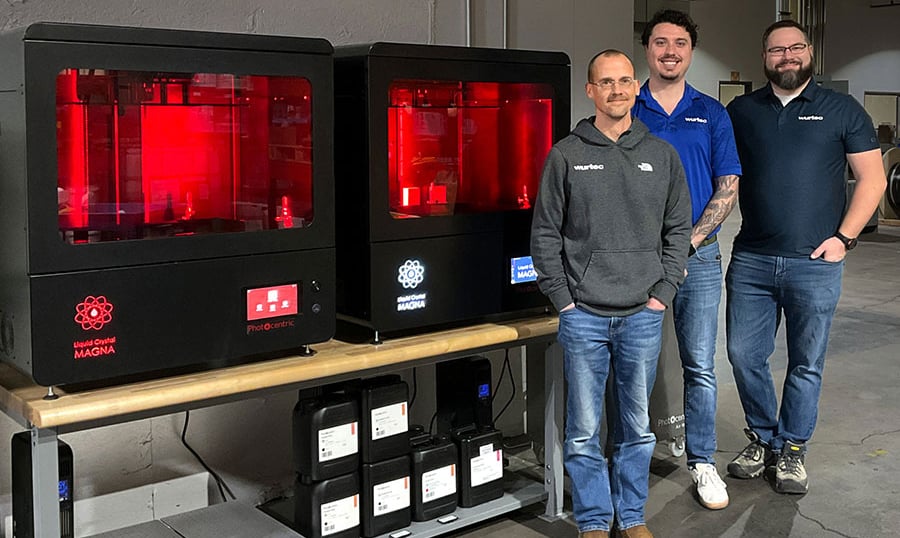
If you need even bigger resin 3D printing, check out the company’s LC Titan, which has a 700 x 395 x 1,200 mm build volume. Print speed is 86 mm/hour print, but at a 350μm layer thickness, volumetric speed jumps to up to 24 liters per hour.
In 2024, Photocentric launched Jeni, a fully autonomous 3D printing platform that automates printing, rinsing, washing, curing, and all material handling.
B9Creations B9 Core 6 Series MPro
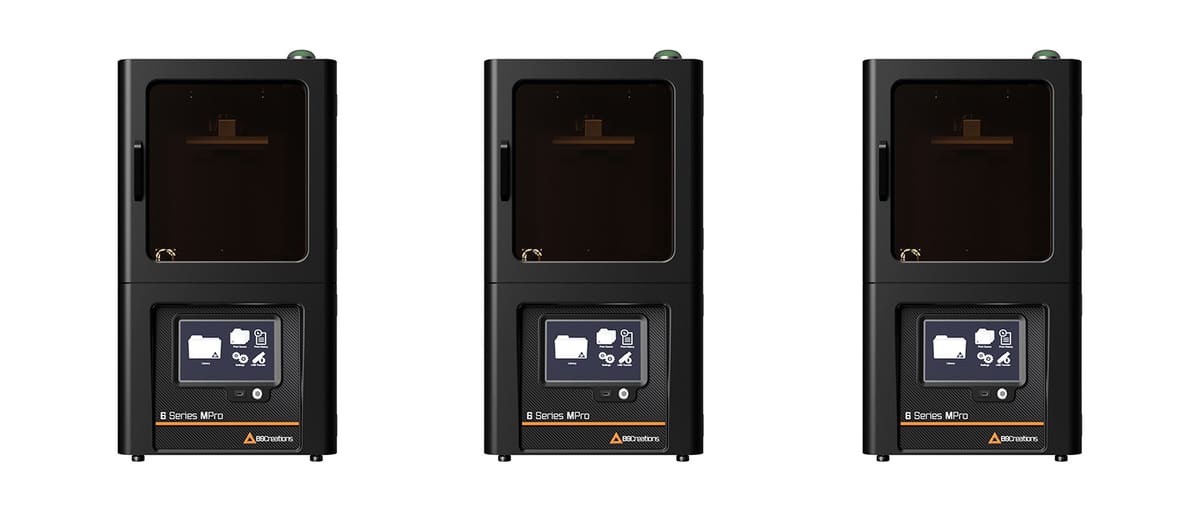
The B9 Core 6 Series MPro is the newest resin 3D printer from US-based B9Creations. It’s a high-precision, large-format 3D printer that, the company says, furthers research and produces functional prototypes and end-use parts with accuracy, consistency, and finishes rivaling injection molding.
The B9 Core Series are open to third-party materials. With B9Captivate, a comprehensive material development toolkit, you can fine-tune settings to suit the chemistry of your custom materials and the geometry of your part. This allows you to engineer settings tailored precisely to your application’s needs.
B9Creations offers several other smaller 3D printers a custom development option. The B9X Custom Platforms is an offering where B9Creations will develop software, build hardware, and design materials around your company’s specific parts, production, and regulatory compliance needs.
If you’re rather just have B9Creations develop and print your parts for you, they have a print service for that, too.
Asiga Ultra 50

For more than a decade, Asiga has been a prominent brand in the dental 3D printing industry, which is its primary focus, but it also makes resin 3D printers for manufacturing. The company’s new Ultra aims to bridge the gap a bit. It’s small (192 x 108 x 147 mm build volume) compared to the rest of the professional printers here, but has enough advanced features to warrant a place.
The Ultra features touchless entry, a magnetic platform holder, and an infrared material hater. The machine is an open material platform.
It is available in two models: the Ultra 32 and the Ultra 50. The Ultra 32 offers a pixel size of 32 microns with a build volume of 119 x 67 x 130 mm (4.68 x 2.63 x 5.11 inches), while the Ultra 50 provides a 50-micron pixel size and a larger build volume of 189 x 106 x 130 mm (7.44 x 4.17 x 5.11 inches).
Both models feature an auto-calibrating UV LED light source operating at a wavelength of 385 nm, with options for 365 nm and 405 nm upon request.
The accompanying Asiga Composer software supports multiple file formats, including STL, SLC, PLY, and the proprietary STM (Asiga Stomp file format), and includes lifetime updates to keep the software current.
The Asiga Ultra 50 is an open material platform, meaning it supports third-party resins in addition to Asiga’s own materials. It is compatible with over 500 qualified resins.
Asiga makes five resin 3D printers: two smaller than the Ultra and two larger.
Stratasys Origin Two
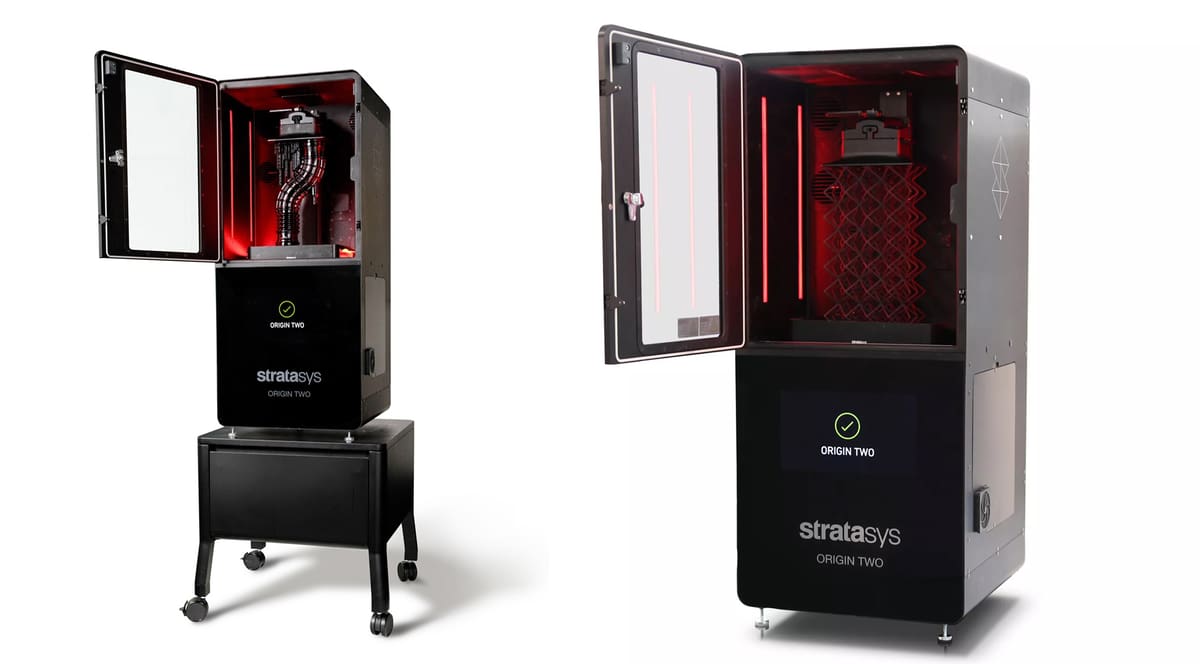
The Stratasys Origin Two, luanched in late 2024, is an industrial-grade DLP 3D printer “engineered to achieve exceptional accuracy, repeatability, and surface finish comparable to injection molding,” the company says.
Of course, resin parts require post-print light curing, but what’s different with the Origin technology, which Stratasys calls Programmable PhotoPolymerization (P3), is that parts straight off the printer are nearly as strong as the final parts and require only a “few minutes” of post-processing, the company says.
The Origin Two is equipped with a 5K DLP projector for a 38.5 micron pixel size. It can achieve “consistently higher accuracy” (+/- 50 microns) than the previous version, a surface finish smoothness of up to RA 3 microns while maintaining high-print speeds up to 20 mm/hour.
The system features an open material platform if you buy the OpenAM License that lets you select from a broad range of high-performance resins validated by Stratasys and its partners while adjusting print settings as needed.
The printer is compatible with GrabCAD Print, which supports various 3D file formats and provides build preparation, support generation, and advanced slicing capabilities.
Stratasys does not publically release the price of this printer but the previous version went for around $90,000.
If you’re looking for a larger-format resin 3D printer, Stratasys offers its Neo line. In April 2025, the company launched a new addition to the line, the Neo 800+.
Rapid Shape I100+
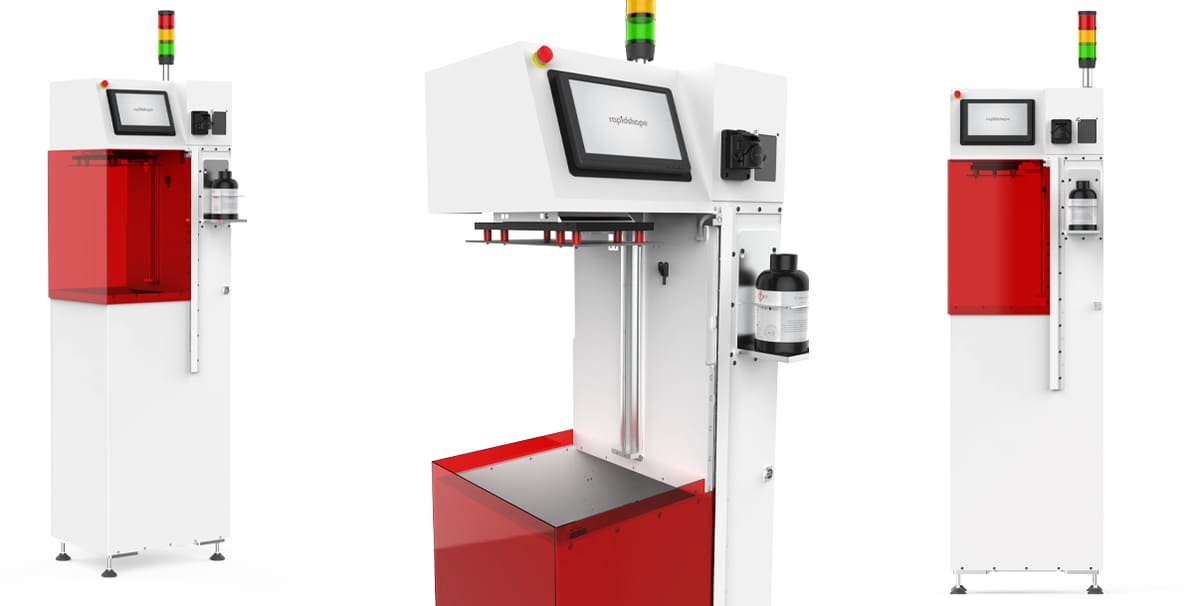
The I100+ is what Rapid Shape calls its workhorse resin 3D printer. Setting it apart from some others is its automation, specifically the automatic separation module (patented) that collects your printed parts in a basket automatically so the next print job can start immediately, all without any manual intervention. There’s also an automatic resin refill unit that takes care of a constantly sufficient filling level of resin material inside the reservoir.
The fully-automated system for producing thousands of parts per day also has a cleaning process that recovers up to 15% of resin to be reused in 3D printing and avoids using any cleaning chemicals. After the printing process, the parts are transported via a conveyor directly into the post-processing, where they are spun at high speeds.
This 24/7 production unit comes with an industrial projection system and internal cooling for all system components. The I100+ is the solution for companies with high-volume needs, including multiple-shift operations.
ETEC Xtreme 8K
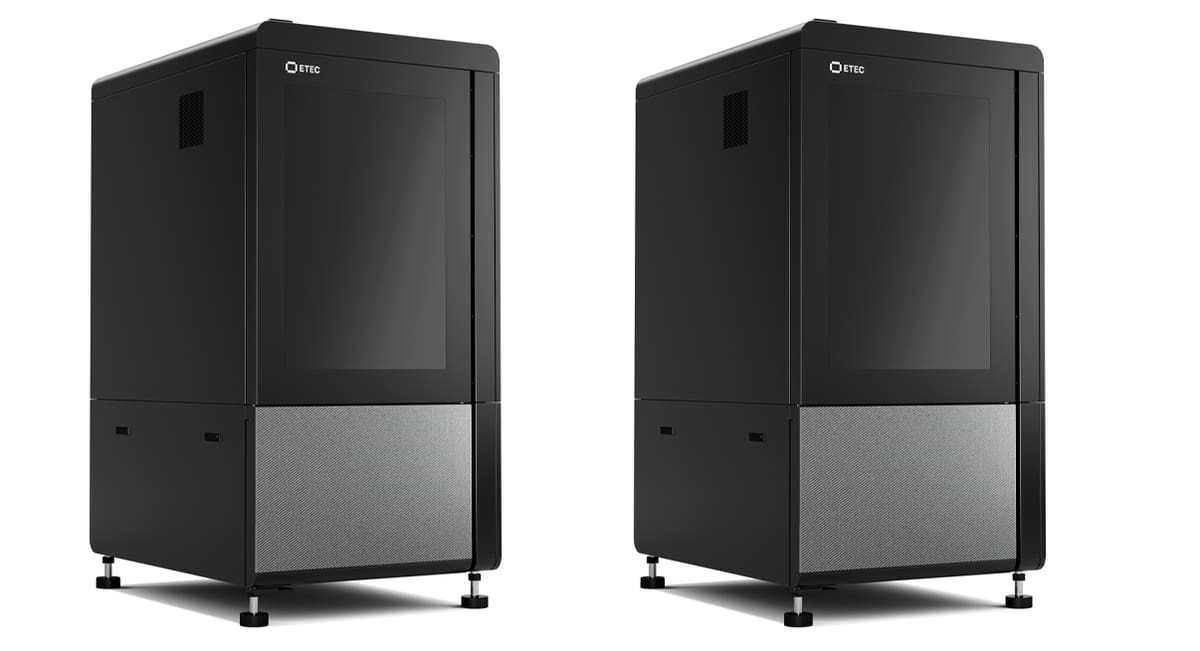
ETEC, a Desktop Metal company, offers the Xtreme 8K resin 3D printer for production-grade and large 3D parts. The Xtreme 8K uses dual 4K projector DLP technology offering a 12W LED light source. Top-down printing enables faster curing of each layer by eliminating the peeling step that is required for traditional DLP systems, the company says. Top-down also means the parts are fully submerged in the material during printing, which calls for fewer support structures, resulting in better surface finishes. Surface roughness can be less than 1 micron RA.
ETEC says the machine is designed to run 24/7 for volume production of 3D-printed parts. With wide material compatibility, including hard plastics, high-temperature plastics, elastomers, and rubbers, the Xtreme 8K produces a wide range of parts.
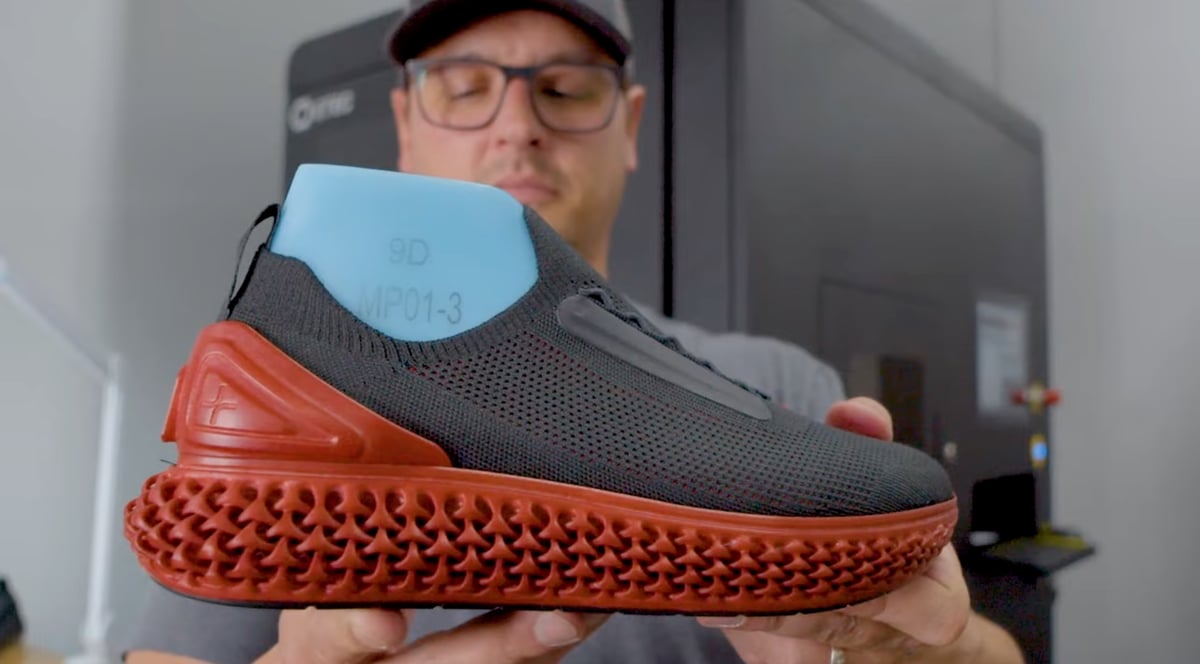
In March 2024, ETEC announced that select Evonik photopolymers and materials are now qualified to be compatible with the Xtreme 8K and the company’s Pro XL 3D printers.
The large build volume allows users to print very large parts, thousands of smaller parts, or mix and match both in one build.
Carbon M3 Max
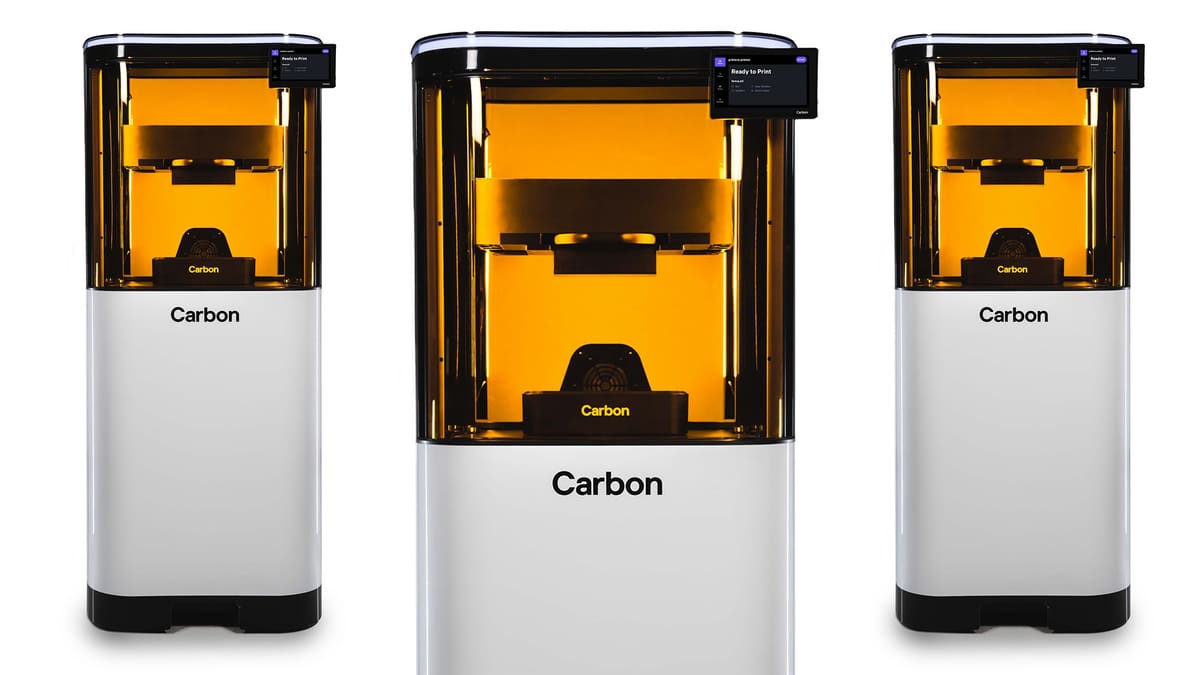
California-based 3D printer maker Carbon launched its latest industrial resin printer, the M3 Max, in 2022. Carbon says the M3 Max provides an “advanced end-to-end idea-to-production platform” when combined with its software, Design Engine, and proprietary Carbon resin materials. Because Carbon’s DPL technology, called Digital Light Synthesis, has some unique features requiring specific resin properties, material selection was a bit of a drawback. But in just the last six months, Carbon has introduced new materials and collaborated with material makers that seem to have solved that problem and grown its material portfolio to 20 in addition to some Flexcera brand resins from Desktop Health.
Although we have our dental 3D printers in another guide, this niche has been a strong focus at Carbon. The company recently introduced new materials and new workflow software for dental labs. On the industrial front, though, there’s the new rigid material, EPX 150, and a new elastomer, EPU 46, for manufacturing.
The M3 Max and the also new M3 are the same size as Carbon’s M2 launched in 2019 but boast a simpler print experience with the help of a new touchscreen that features more printer options.
The Carbon suite includes printers, washers, and curing machines, along with software. Carbon’s software offering is more than a build prep platform, it contains design tools to customize your product, generate multi-zonal lattices, and optimize topology.
Carbon machines are available for lease, not purchase.
3D Systems PSLA

Just debuted late last year the new PSLA 270 from 3D Systems is the company’s “fastest, most versatile, resin printer yet,” it says, producing parts in hours not days.
The PSLA 270 is a DLP 3D printer, although 3D Systems likes to use the term “projector-based SLA” or PSLA.
The PSLA 270 is indeed the company’s fastest resin 3D printer. 3D Systems doesn’t provide technical data in the same format for all of its machines, so comparisons are not simple, but the PSLA 270 appears to have a lower resolution (although still very high) than the slower Figure 4 series machines, while accuracy is lower than the company’s other laser-based 3D printers. Speed always comes at a compromise.
Other features designed for a production environment include the quick-swap, roll-out material chambers, so you can, theoretically, have one material chamber loaded and ready to go as soon as the first is finished so there’s no waiting to clean out one material from the vat. This mobile cart accommodates a variety of material vat sizes and keeps the elevator, displacer, and recoater nested with the vat of resin that they are used with — one cart is simply exchanged for another and all the necessary components come with it. There’s also a large 55-liter resin tank for volume printing.
Regarding mechanical configuration, the PSLA 270 is a “top down” resin 3D printer which is meant to reduce gravity-based distortion and peeling on bulky parts with large cross-sections. Top-down also means the parts are fully submerged in the material during printing, which calls for fewer support structures, resulting in better surface finishes. (ETEC Xtreme 8K from Desktop Metal is another top-down DLP resin printer.)
3D Systems is not releasing a price. When we proposed maybe “$225,000 – $300,000”, the company said that was “wildly wrong” so it’s likely more in the range of the company’s SLA 750 Dual which starts around $425,000.
SoonSer Smart 400H
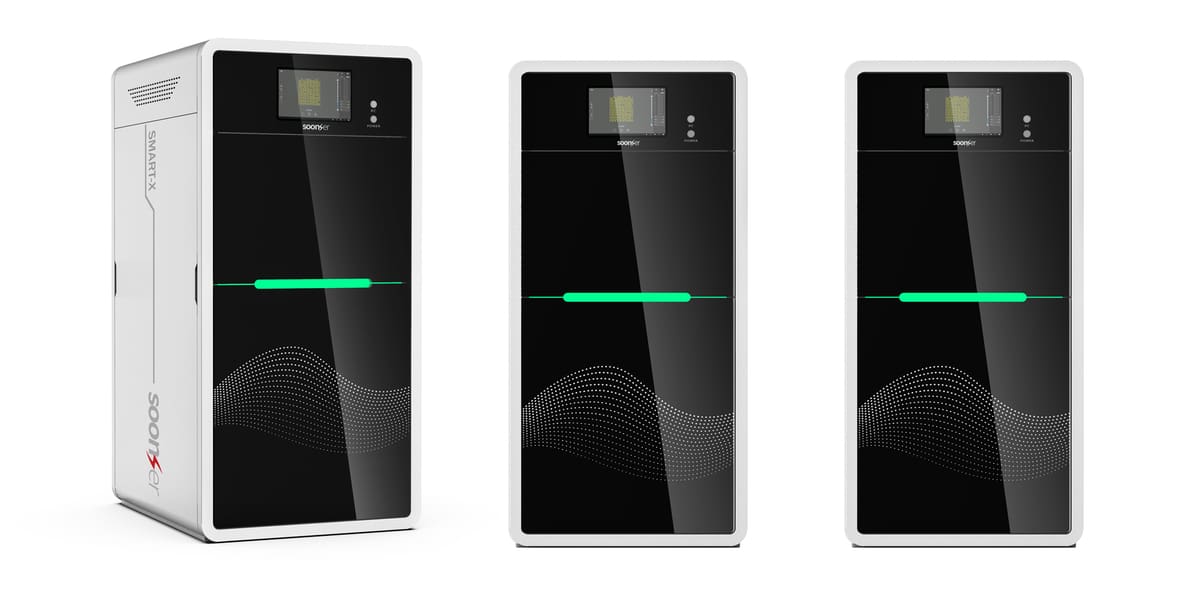
Soon to be available in the US through distributor VoxTech3D, the SoonSer Smare and Mars Pro line are SLA 3D printers that use engineering-grade resin.
The SoonSer Smart 400H combines large build capacity with high precision, user-friendly features, and environmental considerations. Its boasts a print accuracy of ± 0.1 mm for objects less than 100 mm, and ±0.1% for objects 100 mm or larger, ensuring detailed and accurate output, the company says.
User convenience is prioritized through features such as an easy installation build plate, a replaceable resin tank, remote monitoring capabilities, and real-time laser detection, streamlining the printing workflow. The printer also includes an Automatic Guided Control System, offering a fully guided print process with one-click preparation and power outage recovery.
To promote a cleaner working environment, the Smart 400H is equipped with a two-tier deodorization system consisting of an activated carbon filter and a HEPA filter, effectively removing particles.
If the 400H is too small for your needs, SoonSer offers three much larger printers in the Mars line.
Pro Resin 3D Printers: What You Need To Know
What are DLP, SLA & LCD Technologies?
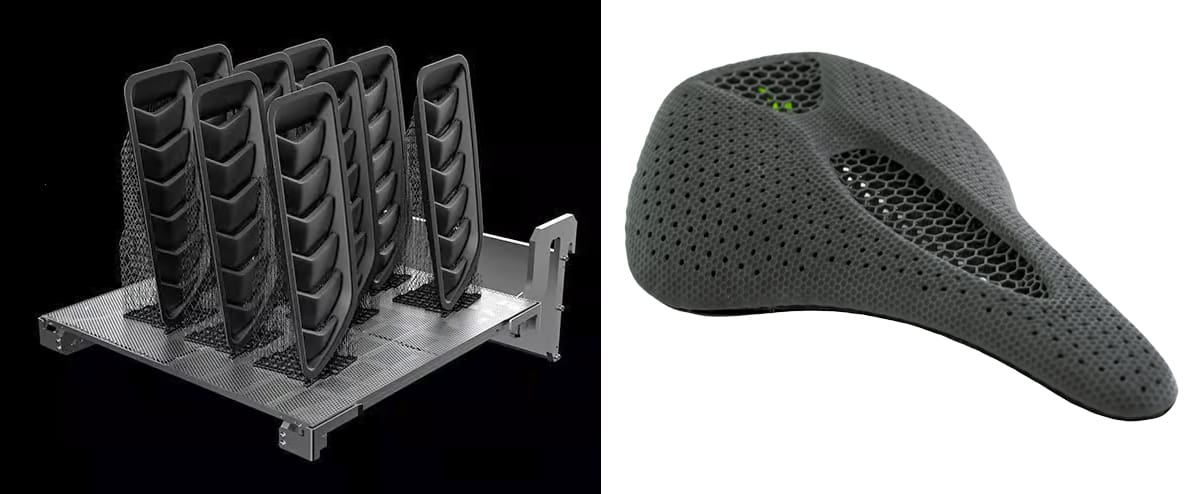
You’ve concluded that resin is right for you, now what? Let’s assume you’re familiar with the basics of resin printing – using a vat of liquid photosensitive plastic exposed to UV light to build an object layer by layer. All resin-based 3D printing, in which a liquid photopolymer resin is stored in a vat (as opposed to being ink-jetted through a nozzle), is collectively known as vat polymerization. All other names are subcategories of this technology.
Within the vat polymerization 3D printing category, you’ll find slightly different printer technologies – stereolithography (SLA), liquid crystal display (LCD), digital light processing (DLP), and others – to create somewhat different results making trade-offs between speed and fine detail, and distinguishing some unique printers from the pack. All of these technologies cure resin using UV light, but how the resin polymer is cured is slightly different.
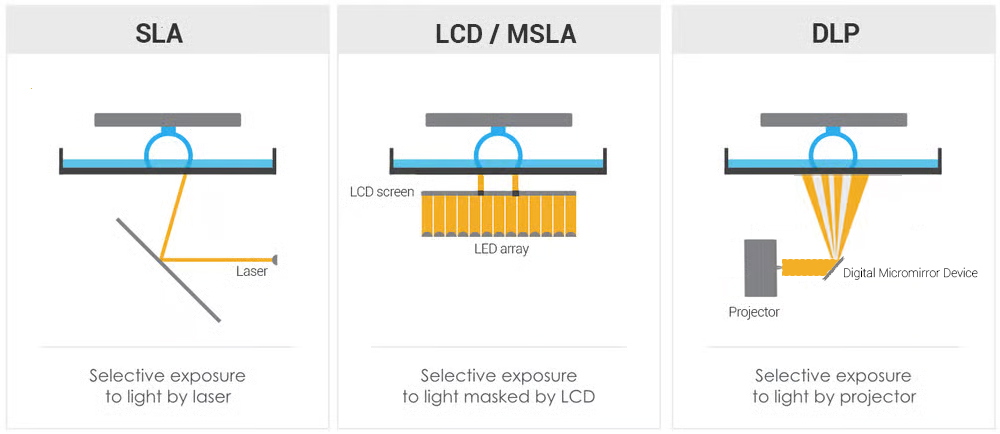
The 3 Major Resin Types in Brief
Stereolithography (SLA) today generally always refers to laser stereolithography, although you might still hear it used as a catch-all term for all types of resin 3D printing. Chuck Hall, who invented the process and coined the term stereolithography, describes it in his 1986 patent as a concentrated “beam” of ultraviolet light focused onto the surface of a vat filled with liquid photopolymer. Today, SLA refers to a machine that uses one or more lasers as the light source.
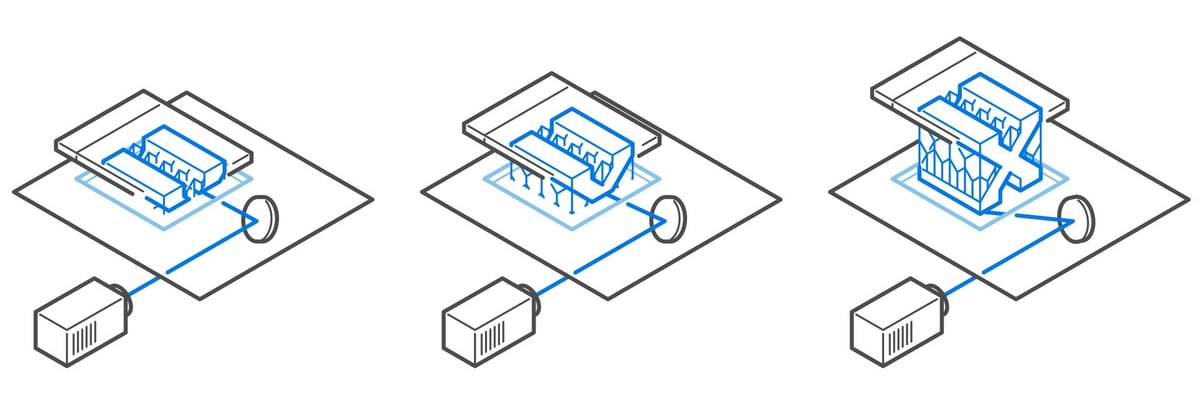
Digital light processing (DLP) uses a digital light projector as its light “engine”. It flashes light onto a digital micromirror device (DMD) consisting of hundreds of thousands of tiny mirrors. Some mirrors direct the light to the resin in the pattern of a cross-section of the part to be printed while other mirrors deflect the light off to the side. Layers generated using DLP printers consist of so-called voxels, the 3D equivalent of pixels. That’s because the projector screen itself consists of pixels. Flashing an entire layer at a time, as you can guess, is faster than tracing the layer with a laser.
Liquid crystal display (LCD) is the third type of vat polymerization also known as masked stereolithography (MSLA). 3D printer manufacturers use these terms interchangeably. This 3D printing technology is nearly the same as DLP in that it flashes a complete layer at the resin tank, but the source of the light is different. Instead of a projector shining on a digital micromirror, the UV light comes from an LED array shining through an LCD screen. The screen acts as a mask, revealing only the pixels necessary for the current layer. Due to the low cost of LCD units compared to projectors and micromirrors, LCD has become a common technology for the budget desktop resin printer segment, but don’t be put off; some printer makers are taking the technology to the next level for professionals.
We’ve already established that DLP and LCD are generally faster than SLA, but which one yields more finely detailed prints? The fact is that all technologies can produce super-fine details, and you may be surprised by the resolution you can get from very affordable machines.
If you want a deep dive into the specifics of resin technology resolution, check out our guide, The Complete Guide to High-Resolution 3D Printers.
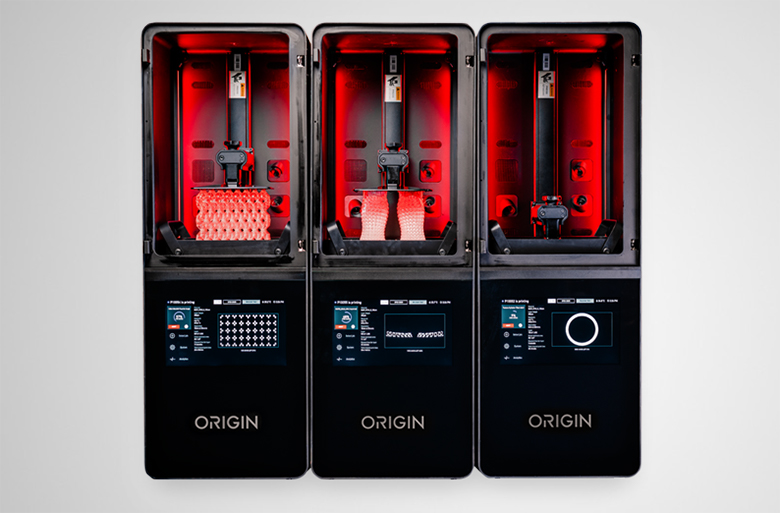
Patented Resin Technologies
Although some patented resin 3D printing technologies are more marketing than science, some manufacturers have variations on the common technologies (SLA, LCD, and DLP) that actually represent significant advances and set their machines apart from the rest.
3D printer manufacturer Carbon, for example, calls its resin printing technology Digital Light Synthesis (DLS), which is a take on DLP. In DLS, the resin pool is exposed to both UV light and oxygen. Unlike traditional layer-by-layer approaches, DLS uses a continuous process where the object is pulled from the resin bath. The bottom of the resin pool has an oxygen-permeable window. Oxygen inhibits the curing process, and by controlling the oxygen levels through the window, the printer can precisely control the solidification of the resin. DLS requires special resins and the entire process is extremely fast.
Printer maker Stratasys offers another take on DLP in its Origin printer called Programmable Photopolymerization (P³). The outstanding feature of P³ is its ability to dynamically adjust the light patterns during the exposure process to create more sophisticated curing profiles, leading to, the company says, improved accuracy and the ability to optimize material properties.
Formlabs offers what it called Low Force Stereolithography (LFS), while Nexa3D has a type of SLA called Lubricant Sublayer Photo-curing (LSPc).
One new technology from start-up Axtra3D combines resin methods, so the core of a part is printed quickly with DLP while the outer shell is printed with finer detail using SLA. The company calls it Hybrid PhotoSynthesis (HPS) technology.
The Details Behind Fine-Detail
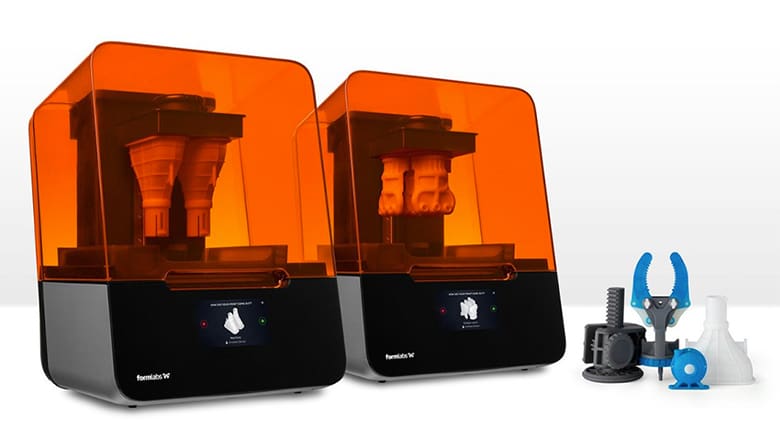
If looking at a printer’s technical specification sheet makes your head spin, know that you won’t find huge differences within comparable price ranges using the same technology. For example, the finest XY resolution for resin printers (apart from the industrial micro 3D printers) is generally around 25 – 50 microns (μm). (For reference, 50 μm is the width of a human hair.)
Some manufacturers only talk about resolution, while others mention resolution and accuracy. Resolution refers to the possible layer thickness, for example, 50 μm or 100 μm. The accuracy refers to the window of error for consistency print after print. For example, an accuracy of +/- 20 μm means your print resolution could be 20 μm over or under what you programmed.
In many industries, accuracy is critical. For most dental applications, professionals typically look for an accuracy of within 50 μm. For fine jewelry, some professionals require an accuracy of 25 μm, and for some medical applications and electronics, companies require an XY printing resolution of 5 μm with an even smaller accuracy, which you can find in a handful of ultra-high micro-precision printers.
The general rule is that the higher the resolution, the longer your parts will take to print. But this is where professionals and industrial machines differ from consumer resin printers, printing high-resolution parts quickly.
For a deep dive into resin printer resolution, such as what 4K and 8K resolution refers to and terms like pixel-shift really mean, check out our guide to resolution linked below.
The Fastest Resin Printer
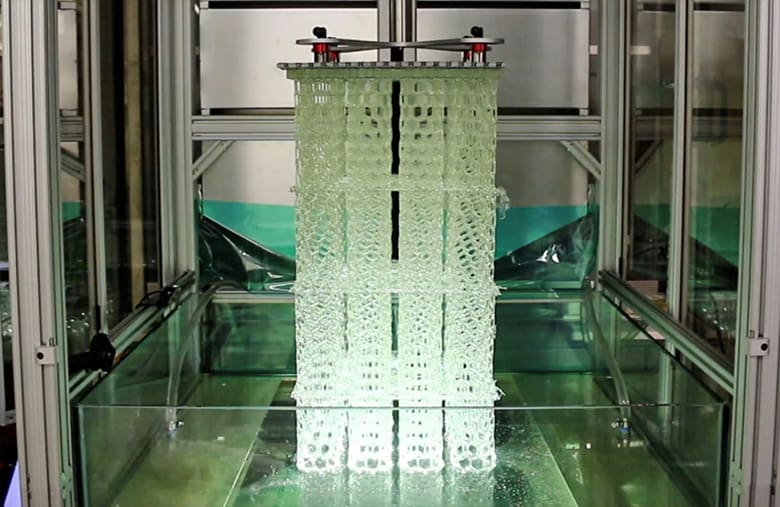
There’s a long list of resin 3D printer makers that claim to have the fastest machine, but the comparisons are often apples to oranges considering all of the variables and technologies involved.
Speed in resin printers depends on the selected print resolution, materials, and volume, plus the type and quality of the light source. This is why there are $2k resin printers, and then there are $100k resin printers. That being said, there are some technologies that are faster than others.
For example, single-laser SLA is slower than DLP and LCD. The lasers used in SLA have to trace out each layer. However, projector and LCD light source-based printing methods tend to be faster because they don’t trace out each layer being printed point by point; they cure entire layers in one flash. The quality and intensity of the light source may cure the resin even faster.
When you’re shopping for a resin printer, many manufacturers will give you an example speed. For example, sportswear giant Adidas says it can produce a shoe midsole in 20 minutes on Carbon printers. Formlabs gets specific with its claim to print a single retainer in its Dental LT Clear resin in 50 minutes, while Photocentric says its LC Magna printer can churn out 48 dental models horizontally on a build platform in 80 minutes.
If you have a particular product or type of part in mind to print, you can send the manufacturer the file and it can tell you about how long your parts will take on its machine.
Once you’ve narrowed down three to five printers that meet your needs, take them for a test drive if possible, but, at the very least, request free sample prints with specs on how long the print took to complete.
Accessories You'll Need: Print, Wash, Cure
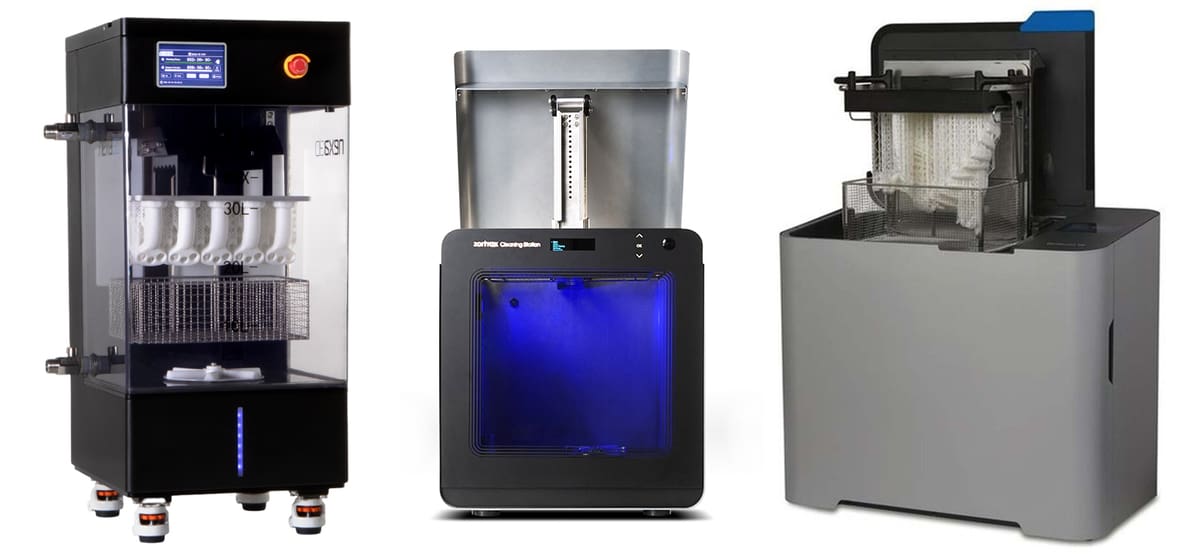
Parts don’t emerge from resin 3D printers ready to use, in fact they’re completely useless. Parts may be only partially polymerized (not fully cured) when they leave the printer, creating opportunities for warping in the cleaning and curing steps. This is one of the drawbacks to resin printing; the often-messy and somewhat labor-intensive post-processing.
Although industrial printers and many professional ones have a fully automated print-wash-cure process, others require more equipment, namely a washing unit and a curing unit.
Indeed, the sophistication of your printer and the quality of your resins are proportional to the amount of post-processing labor involved. So if you’re spending too much time and effort post-processing to get the desired quality, consider upgrading your resin, your printer, or both.
Most resin parts need support structures during printing that require removal after printing. Removing supports and the marks they leave on the surface may involve sanding or polishing.
Most resin printer manufacturers make their own accessory machines (if they are not fully incorporated into one unit) and many produce their own post-processing chemicals, but you’re not limited to selecting only from your printer manufacturer’s offerings. Shop around for the accessories that best fit your needs and budget.
Materials: Understand Your Options
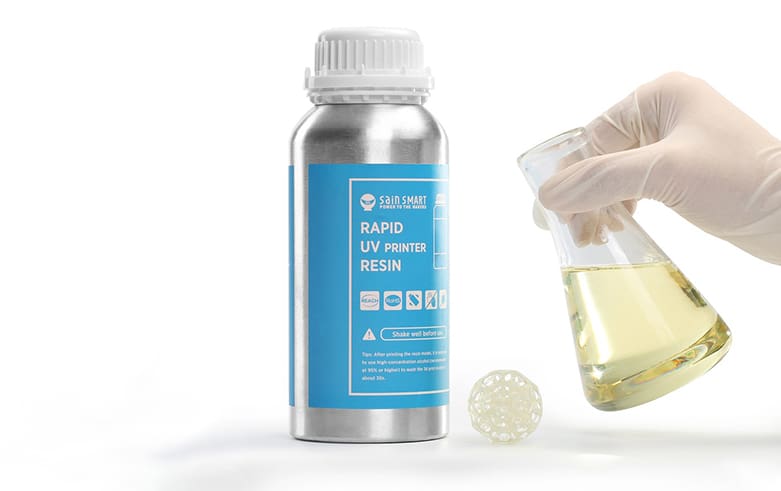
Resin manufacturers will argue that it’s the materials that make the print, and that may often be true. There are thousands of materials available for resin printing from a wide range of manufacturers and at prices ranging from $15 a liter to more than $300. In fact, you can resin-print in everything from a highly flexible silicone-like material to a metal-infused polymer.
Your resin 3D printer, however, is either restricted to proprietary resins or it’s an “open material” machine, meaning it can print with a wide range of third-party materials offering great flexibility but also a bit of trial and error to dial in the print settings just right. To cut down on the tinkering, printer makers often work directly with the resin material developers to establish optimal setting. You may hear of certain materials being “certified” for certain printers. This is something to look for, since it’s designed to save you time and money.
Resin Variety
Resins come in a full rainbow of colors, transparencies, properties, and textures. At the dawn of resin 3D printing, most printed parts were stiff and brittle. Those days are long gone. There are flexible resins, durable resins, filled-resins, hybrid resins, exotic resins, biocompatible resins, and degradable plant-based resins among many more categories. Yet, because most professional resins are trademarked, proprietary formulas, it can be difficult to understand the differences. For example, most resin makers offer a “tough” resin, but how one tough resin compares to another is often difficult to track down.
Note that resins are typically formulated to be responsive to specific wavelengths of UV light, such as 355 nm, 385 nm, or 405 nm. If you’re 3D printer emits 355 nm light, don’t use a 405 nm resin. Fortunately, most resins today will cure in all three wavelengths, but always follow the manufacturer’s recommendations for resin compatibility and curing conditions to achieve the best results in 3D printing.
Likewise, a resin formulated for a DLP 3D printer may not work in an SLA printer, so read labels carefully.
Manufacturer vs. Third-Party Materials
A resin printer’s claims of accuracy, speed, and quality are based on using specific resins. Although you can use third-party resins in many resin printers, your results may not match what the manufacturer claims its printer can produce. For example, the resin part may not fully cure or may not print as fast with a third-party material.
Despite the risks of uncertified third-party materials, a resin printer with an open-mode or experimental mode for materials is an important feature. Material manufacturers are introducing new resins so quickly that it’s often not possible for printer manufacturers to keep up on certifying or adapting innovative materials for use in their machines. Open-mode enables you to take advantage of the latest developments in materials.
Several printer manufacturers have alliances with major chemical companies to research and develop proprietary materials. For example, Nexa3D and global chemical company Henkel have launched a resin called xMED412, which is a high-impact, durable plastic that has also been tested and cleared by the U.S. Food and Drug Administration (FDA) for use within clinical environments.
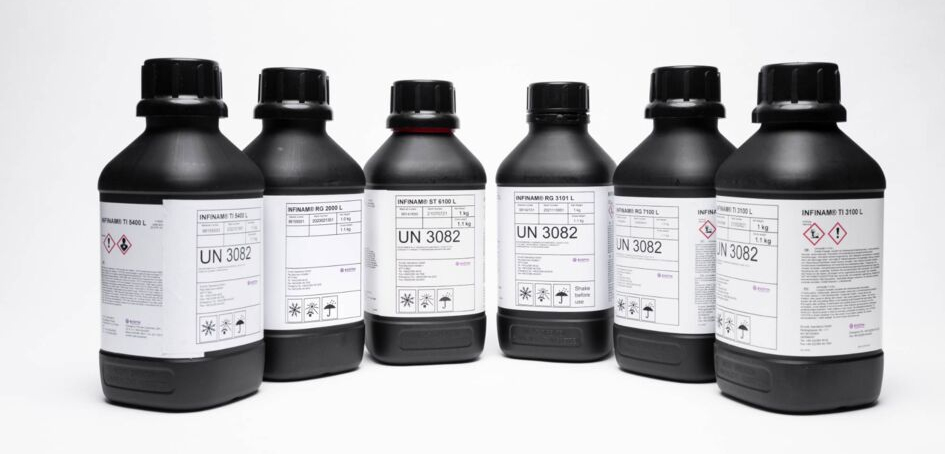
Of course, there are plenty of high-quality resins by third-party manufacturers that will work as good or even better in whichever machine you choose. The only drawback, as we mentioned above, is taking the extra time to experiment and fine-tune your print settings and post-processing to get the print you require.
Many resin manufacturers, including Liqcreate, offer custom material development to fit your company’s specific needs for colors, properties, and the specific printer you’re using. In fact the company has produced nearly two dozen custom resins in the past few years.
By working with engineers at consumer product companies, such as Adidas, Invisalign, and Riddell, resin manufacturers have researched and created application-specific resins and helped 3D printing to rival injection molding and further the mass production of end-use products.
If you have specific requirements for your final part’s stiffness, strength, stretch, durability, heat resistance, or other attributes, check out the materials’ technical data sheet, which should provide details including tensile strength, percent of elongation at break, and water absorption.
Ultimately, where you buy your resins may be tied to your location. Although companies in Europe and the North America may have the widest selection of vendors to choose from, companies elsewhere may want to first try sourcing resins locally before paying shipping and import duties for the printer manufacturer brands.
Where to Buy Resins for 3D Printing
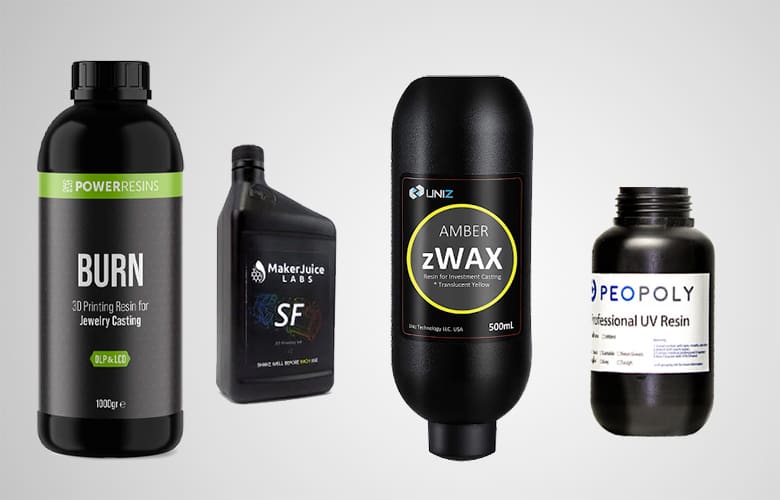
To uncover which machine will best meet your needs and budget, first ask yourself:
- What are the qualities of the parts I need to print (flexible, sturdy, clear, etc.) and will I want to print different parts with different qualities?
- How exact are my detail requirements? For example, dental applications typically require print detail within 50 microns, while product prototypes may require far less detail.
- How big are the prints I need to make? Note that a large build volume can create one large item, such as a helmet, or many small items, such as 60 individual parts.
- How much do I plan to print, and how quickly do I need them printed?
- Will I need to use biocompatible materials?
- Are there printers specific to my market, such as dental and jewelry?
- Do I have space and labor available for post-processing and the associated machines?
Although we give price ranges for the printers in our list, don’t let that be your only guide. As with any major equipment purchase for your business, carefully evaluate durability and ease of maintenance, warranties and support, plus the maturity of the technology and the level of industry adoption.
Resin printer manufacturers tout the uniformity and life span of their light sources, the ease of calibrating their build plate, the intuitiveness of their user interface, and special features, such as real-time image monitoring, software-driven control over conditions inside the vat, and a robust menu of compatible materials. Other bells and whistles of resin printers include mess-free resin cartridges, integrated automatic print-wash-cure handling, and variable temperature printing.
These features, and many more, will make – depending on your use case – subtle or significant differences in your workflow, efficiency, and end result.
Your printer manufacturer or reseller is the first place to turn for resin materials, but there are a host of third-party resellers for printer-branded resins plus alternative resins that also may work well in your resin printer. Third-party resins will either list the compatible printer or give a general statement, such as “this resin is designed for printing on DLP/LCD 3D printers.” These third-party resins may be a risk and take some experimenting, but can often be up to half the cost of the manufacturer resins.
Get Your Parts From a Service
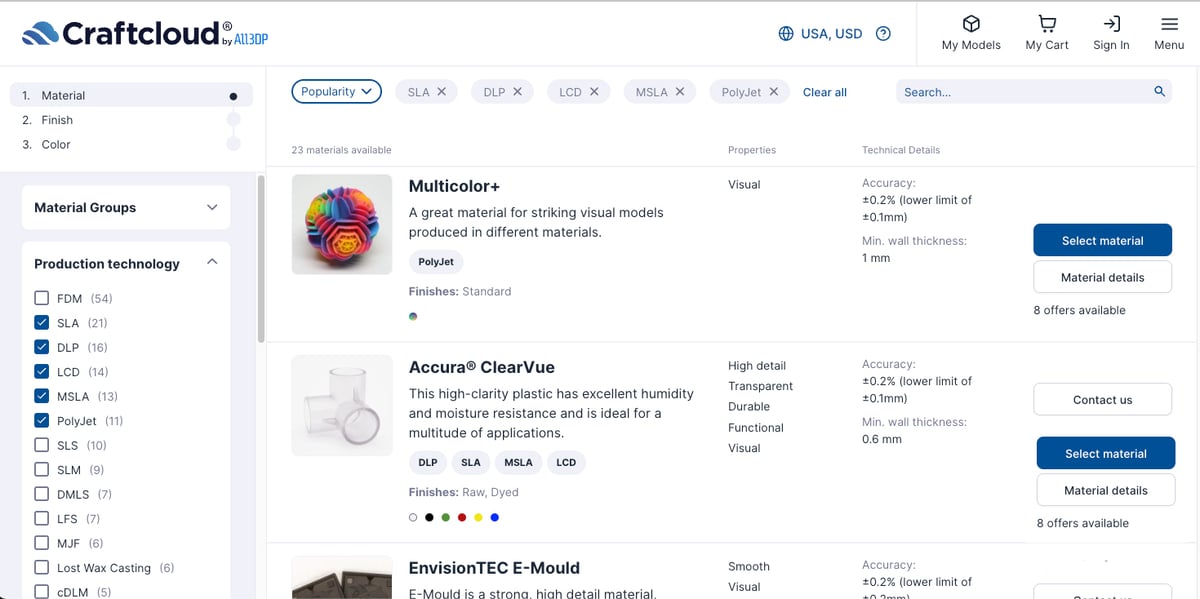
Today’s wide range of 3D printing services can guide you through the options and materials available for resin 3D printing, but some may leave you on your own to figure out the best option. Whether your project involves one unique gift for a friend, several jewelry molds, or hundreds, even thousands, of parts for your business, we’ve collected and reviewed the top resin 3D printing services providing a range of material and technology options to help you choose the best one in the guide linked below.
In fact, we put them to the test with a few resin-based part projects.
Lead image source: All3DP
License: The text of "Best Pro Resin 3D Printers 2025: From $3,500 to $420,000+" by All3DP Pro is licensed under a Creative Commons Attribution 4.0 International License.
CERTAIN CONTENT THAT APPEARS ON THIS SITE COMES FROM AMAZON. THIS CONTENT IS PROVIDED ‘AS IS’ AND IS SUBJECT TO CHANGE OR REMOVAL AT ANY TIME.



